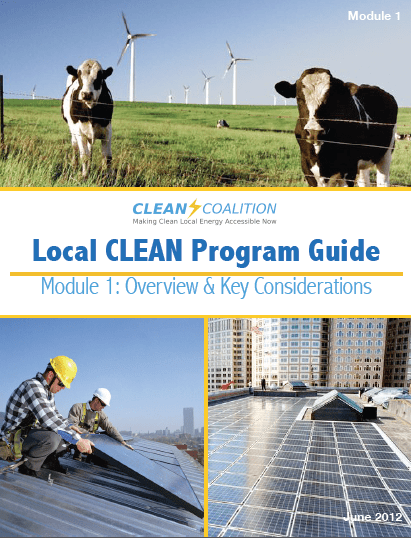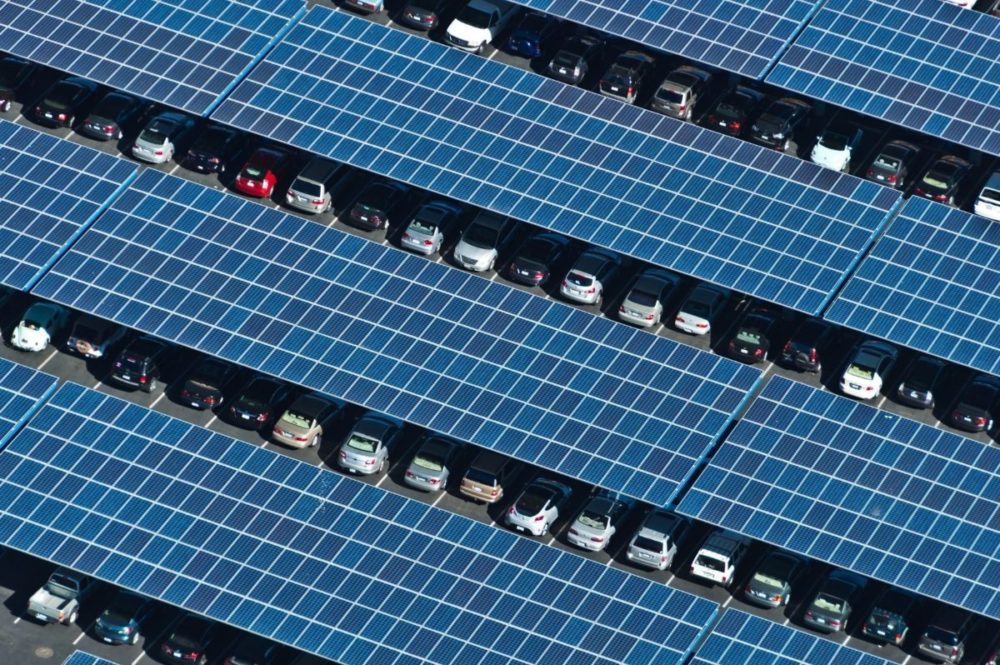These templates and examples help advocates pitch, design, and enact new clean local energy legislation.
CLEAN legislation summary template
Updated August 29, 2013. The CLEAN legislation summary template provides an example structure for a clean energy advocate to quickly craft a 1-2 page summary document for CLEAN Program legislation. The customized summary is meant to be presented to elected officials and potential partners in order to have them consider a full legislative proposal.
CLEAN legislation proposal example
Updated September 18, 2013. The proposal example is a bill proposal for a hypothetical new 2,000 MW CLEAN Program in California. This is an example of a proposal that would be submitted by a legislator to their legislative counsel for crafting a new bill.
CLEAN legislation proposal template
Updated September 18, 2013. The CLEAN legislation proposal template provides structure and example language for a clean energy advocate to quickly craft a new CLEAN Program bill proposal for their state legislature. The customized bill proposal is intended for an elected official that is interested in authoring/sponsoring the bill.
CLEAN legislation – examples & references
Updated September 11, 2013. Following the tremendous success of the German Feed-in Tariff programs, several US states have enacted or at least proposed state legislation to implement similar clean energy procurement programs. This document summarizes notable examples of such legislation and highlights specific sections of these bills that could be useful provisions for future legislation.
Interconnection costs legislation examples
Updated November 8, 2013. As more wholesale distributed generation (WDG) programs are created and WDG projects are deployed, the costs of interconnection can emerge as a significant barrier. This document summarizes notable examples of legislation that address interconnection costs, from simple reporting and transparency to cost allocation between the utility and the project developer.
In-state renewables brief
Updated July 25, 2013. This documents describes the Clean Coalition’s suggested legal provisions for keeping the deployment of new renewables in-state. This information will be generally usable for RPS laws, CLEAN laws, or other renewables procurement mandates.
CLEAN Programs are responsible for the majority of renewable energy deployed worldwide. To learn more about CLEAN Programs and how they work, see the CLEAN Program Guide above. The resources below provide additional details for creating an effective procurement program.
Drafting legislation
CLEAN legislative materials
The templates and examples in the Legislative materials section above help advocates pitch, design, and enact new CLEAN legislation.
Generating support
CLEAN Programs communications collateral
See the communications materials above to help build support for a statewide CLEAN Program.
CLEAN Programs standard deck
The Standard Deck is the latest set of powerpoint slides that define and help make the case for CLEAN Programs to bring online wholesale distributed generation in a timely and cost-effective way.
CLEAN Program Guide, Module 7: Gaining Support
Similar to the Communications Collateral, this section of the CLEAN Program Guide, found above, provides examples and materials to build support for CLEAN Programs.
Pricing and avoided costs
CLEAN Program Guide, Module 3: Avoided Costs
This module of the guide above outlines how clean local energy saves money for utilities and ratepayers.
CLEAN Program Guide, Module 2: Establishing CLEAN contract prices
This module of the guide above explains effective pricing for CLEAN Programs.
State CLEAN Program pricing guide
Updated August 13, 2013. Explains the major approaches used to set the initial price at the start of a program as well as the ongoing price adjustment mechanisms.
State Market Responsive Pricing guide
Updated May 7, 2013. Explains the concept of adjusting the pricing for CLEAN Programs based on the volume of projects that participate at a particular price.
Program size
CLEAN Program Guide, Module 4: Program Size
This module of the guide above helps advocates determine program size and cost impacts.
Policies and procedures
CLEAN model PPA
Updated August 15, 2013. A full legal contract for the sale of energy to utilities under a CLEAN Program. The current version of the document was proposed specifically for California’s SB 32 Re-MAT program, and thus retains considerable California-specific material. However, this version does capture much of the latest thinking on fair and efficient contract provisions for wholesale distributed generation.
CLEAN Program Guide, Module 6: Designing CLEAN policies and procedures
This module of the guide above discusses CLEAN Program policies and procedures that can effectively bring renewable energy online.
State CLEAN Program Rules & Best Practices Guide
Updated September 21, 2013. Provides recommendations for key design areas aside from pricing, such as eligibility, security deposits, queue management, and seller concentration.
Frequently asked questions
Can my community start its own CLEAN Program?
The short answer is “yes.” The long answer is a little more complicated, and we at the Clean Coalition have the resources — including our CLEAN Program Guide above — to help you.
Overview
- Communities in states with statewide CLEAN Programs — Maine, Hawaii, Oregon, and Vermont — can contact us to help design a local program that will achieve the goals of your community. If your state doesn’t have a statewide CLEAN Program, one can be created though legislation.
- If you get your electricity through a municipal utility or a cooperative, your community can request implementation of a CLEAN Program.
- If you get your electricity through an investor-owned utility, local leaders might be able to negotiate a CLEAN Program with the utility. A number of cities and states have also enacted legislation that requires investor-owned utilities to embrace CLEAN Programs.
Special situations
- Communities with Community Choice Aggregation or other procurement rights can implement the procurement features of a CLEAN Program through the community purchasing authority.
- If your community doesn’t control procurement rights and the utility won’t cooperate, you can set up a Hybrid CLEAN Program and still harness the power of clean, local energy resources:
- If your community controls wholesale electricity purchases but not the local grid, it can implement a CLEAN Program without the grid access features.
- If your community controls neither wholesale electricity purchase nor the local grid, it can implement a CLEAN Campus Program.
Does my community have enough renewable resources to make a CLEAN Program worthwhile?
Almost certainly. For example, studies have shown that almost every state could get 20% or more of its electricity from solar power alone.
But every community is different, and most lack policies that allow residents and businesses to take advantage of their local renewable energy resources. That’s where CLEAN comes in, and that’s where we can help.
There are several tools available to help communities evaluate their renewable options. Click here to access calculators and tools provided by the U.S. Department of Energy.
Can our local electric grid handle more renewables?
Most local grids in the U.S. can support significantly higher levels of local renewable energy generation without significant upgrades.
Through our Community Microgrid Initiative, we are working with utilities to launch three demonstration projects across the country by the end of 2016. Each demonstration project will prove that a local distribution grid, without major upgrades, is able to get at least 25% of the electricity it needs from local renewables while maintaining or improving grid reliability.
General information
Consumers
Communities across the country are finding that the development of local, renewable power projects diversifies the energy supply, which insulates consumers from fossil-fuel price spikes and shortages. Diversifying the energy supply also protects communities from blackouts by mitigating the impact of any single power station or power line failing. And by reducing harmful pollutants and greenhouse gas emissions associated with the burning of fossil fuels, renewable generation protects communities’ access to clean air and clean water.
Opening the energy market to small-scale generation also creates economic opportunities. No longer are individuals, businesses, and organizations limited to consuming energy — they can generate it, as well. Communities can turn underutilized spaces — like rooftops and parking lots — into energy-generating assets, powered by clean sources like the sun and the wind.
Municipalities and utilities
Clean local energy projects are helping municipalities and utilities meet local and state renewable-energy and sustainability goals while keeping costs and administrative burdens to a minimum. Proven, cost-effective programs can help add local renewable capacity, while avoiding the lengthy and expensive process of building new, large, centralized power plants and transmission lines.
Adding local, renewable power can help establish your municipality or utility as forward-thinking and dedicated to helping the communities you serve meet sustainability and economic-development goals. Integrate renewables intelligent grid solutions, and you can mitigate the impact of future blackouts by improving the reliability of your grid. See our work on Community Microgrids to learn more.
The City of Palo Alto Utilities, Long Island Power Authority, and Los Angeles Department of Water and Power are just a few of the utilities that have collaborated with us to develop effective CLEAN Programs.
Cities across the nation are finding that encouraging clean local energy leverages private investment to spur economic development, build a more resilient grid, and diversify their power supply. Over time, adding renewables to the mix can reduce electric bills for families, businesses, and city governments alike.
Developing clean local energy also offers a cost-effective strategy for cities to meet renewable energy and sustainability goals. And it offers a way to turn underutilized spaces — from rooftops to parking lots to wastewater treatment plants — into productive places generating clean, affordable power.
Since establishing a CLEAN Program in 2009, the city of Gainesville, Florida has grown its solar photovoltaic capacity by 3,500% and created nearly 300 local jobs, while increasing the price of energy by less than 1%. Gainesville, with more than 12 megawatts of installed solar capacity for its 200,000 residents, boasts an installed solar capacity per capita that is more than triple the United States average. To recreate Gainesville’s success in your city, check out the toolbox below.
States
From Vermont to California, statewide clean energy programs are unleashing private investment and spurring economic development while ensuring a more secure, resilient, and affordable power supply.
A statewide Clean Local Energy Accessible Now Program offers proven strategies for turning underutilized spaces — from brownfields to rooftops — into productive places generating clean, affordable power.
This is especially important for states that have renewable energy targets or climate-related goals. Developing clean energy on the local scale is a fast and efficient way to cut pollution and greenhouse gas emissions, while boosting renewable energy generation and spurring economic development. These projects can be brought online without costing taxpayers or consumers. And they avoid the divisive wrangling that so often trips up grand plans for large-scale, centralized power plants.
Adding distributed generation and intelligent grid solutions to your state’s energy portfolio can improve the reliability of the grid, making blackouts less likely. See our Community Microgrids to learn more.
 Please contact the Clean Coalition if you have any questions about the CLEAN Program Guide or if you are interested in becoming a champion for a CLEAN Program in your community.
Please contact the Clean Coalition if you have any questions about the CLEAN Program Guide or if you are interested in becoming a champion for a CLEAN Program in your community.
